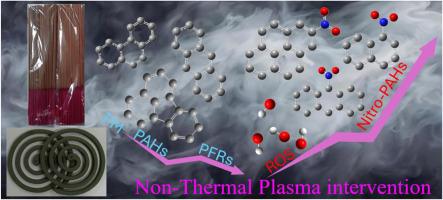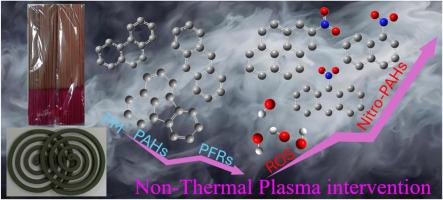Exploring PFRs, ROS, PAHs, nitro-PAHs, and health risks of the nonthermal plasma intervention size-segregated smoldering incense and mosquito coils aerosols
IF 7.3
2区 环境科学与生态学
Q1 ENVIRONMENTAL SCIENCES
引用次数: 0
Abstract
Persistent free radicals (PFRs) are emerging pollutants, and particulate matter (PM) containing PFRs can generate reactive oxygen species (ROS), which may pose health risks. This study analyzes emissions of size-segregated aerosols from indoor sources, including incense and mosquito coils, during nonthermal plasma (NTP) intervention. The focus is on PM-bound PFRs, ROS, polycyclic aromatic hydrocarbons (PAHs), and nitrated polycyclic aromatic hydrocarbons (nitro-PAHs). The results show that emissions primarily consist of PM2.5, with PM1 being the dominant fraction within PM2.5 (73–93 % PM2.5). ROS analysis indicated that PM1 generated OH, R, and H free radicals, while PM1-2.5 generated only OH free radicals. NTP intervention reduced total suspended particles and PM2.5 concentrations while lowering PFR concentrations in the air. Analysis of PAHs and nitro-PAHs indicated that reactive species produced by NTP promoted the formation of nitro-PAHs. A risk assessment using cigarette exposure equivalents showed that PFR exposure during worship was roughly equivalent to 0.0076 cigarettes. Using a personal NTP air purifier reduced exposure by 64 %. These findings highlight the health risks associated with indoor incense and mosquito coil use and emphasize the importance of NTP intervention in air purification strategies, providing valuable insights for improving air quality assessments.


探讨非热等离子体干预尺寸隔离阴燃熏香和蚊香气溶胶的PFRs、ROS、PAHs、硝基PAHs及健康风险
持久性自由基(PFRs)是一种新兴的污染物,含有PFRs的颗粒物(PM)可产生活性氧(ROS),对人体健康构成威胁。本研究分析了在非热等离子体(NTP)干预期间,来自室内源(包括熏香和蚊香)的大小分离气溶胶的排放。重点是pm结合的pfr, ROS,多环芳烃(PAHs)和硝化多环芳烃(硝基多环芳烃)。结果表明,PM2.5是主要污染物,其中PM1占主导地位(占PM2.5的73-93%)。ROS分析表明,PM1产生OH、R和H自由基,而PM1-2.5只产生OH自由基。国家结核控制项目干预减少了总悬浮颗粒和PM2.5浓度,同时降低了空气中的PFR浓度。对多环芳烃和硝基多环芳烃的分析表明,NTP产生的活性物质促进了硝基多环芳烃的形成。使用香烟暴露当量进行的风险评估显示,礼拜期间PFR暴露大致相当于0.0076支香烟。使用个人NTP空气净化器可减少64%的暴露。这些发现突出了与室内熏香和蚊香使用有关的健康风险,并强调了国家毒理规划干预空气净化战略的重要性,为改进空气质量评估提供了宝贵的见解。
本文章由计算机程序翻译,如有差异,请以英文原文为准。
求助全文
约1分钟内获得全文
求助全文
来源期刊

Environmental Pollution
环境科学-环境科学
CiteScore
16.00
自引率
6.70%
发文量
2082
审稿时长
2.9 months
期刊介绍:
Environmental Pollution is an international peer-reviewed journal that publishes high-quality research papers and review articles covering all aspects of environmental pollution and its impacts on ecosystems and human health.
Subject areas include, but are not limited to:
• Sources and occurrences of pollutants that are clearly defined and measured in environmental compartments, food and food-related items, and human bodies;
• Interlinks between contaminant exposure and biological, ecological, and human health effects, including those of climate change;
• Contaminants of emerging concerns (including but not limited to antibiotic resistant microorganisms or genes, microplastics/nanoplastics, electronic wastes, light, and noise) and/or their biological, ecological, or human health effects;
• Laboratory and field studies on the remediation/mitigation of environmental pollution via new techniques and with clear links to biological, ecological, or human health effects;
• Modeling of pollution processes, patterns, or trends that is of clear environmental and/or human health interest;
• New techniques that measure and examine environmental occurrences, transport, behavior, and effects of pollutants within the environment or the laboratory, provided that they can be clearly used to address problems within regional or global environmental compartments.
 求助内容:
求助内容: 应助结果提醒方式:
应助结果提醒方式:


